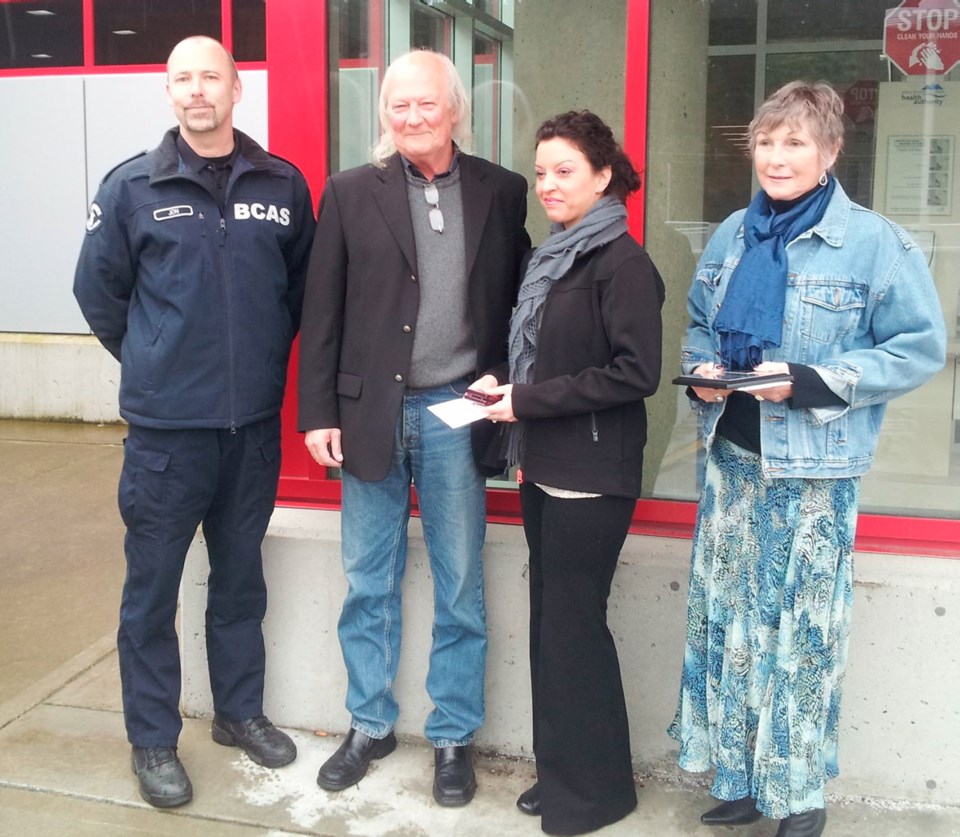Douglas Willoughby is living proof that early CPR saves lives.
On the morning of May 26, Willoughby was sitting at the traffic light on the Helmcken Road off-ramp of the Trans-Canada Highway when he went into full cardiac arrest.
Lucky for him, Nicole Smart was in the car just ahead of him.
Lucky for him, Joyce Hodd was right behind.
Smart, who was on her way to work in the records department of Victoria General Hospital, noticed his car didn’t move when the light turned green.
At the same moment, Hodd saw Willoughby slump sideways in his seat.
Both women jumped out of their cars and pulled him onto the road. Smart, who had taken a CPR course 10 years earlier, started CPR — and started saving his life.
On Thursday, Smart and Hodd were recognized by the B.C. Ambulance Service in a ceremony at Victoria General Hospital. Smart was honoured with a Vital Link Award for performing cardiopulmonary resuscitation during a medical emergency. Hodd received a B.C. Ambulance Good Samaritan Award for her humanitarian assistance during a medical emergency.
Jon Deakin, a B.C. Ambulance advanced life support paramedic, gave the two women their awards.
“These two women did a wonderful thing and it’s because they were trained and they knew what to do that it had a positive outcome,” said Deakin, who was dispatched to help.
Deakin arrived to find traffic stopped and the two women performing CPR in the middle of the road.
A retired cardiologist and an off-duty volunteer firefighter had also stopped to help.
“My partner and I went in and carried out our usual resuscitation procedures,” Deakin said. “He was in full cardiac arrest — no breathing, no pulse whatsoever. We did get pulses back very quickly and continued to resuscitate him and transported him to Royal Jubilee coronary care unit.”
Emergency services often get credited for saving lives, Deakin said.
“But the reality is that more and more studies are showing what really saves lives in these situations is early and effective CPR. It’s early 911, early CPR and early defibrillation and early advanced care for the patient. That’s what they call the chain of survival.”
During his 24-year career, Deakin has seen increasing education and awareness of early CPR — and a significant rise in survival rates.
“Doug Willoughby is living proof. He’s living a productive life now.”
Willoughby, now 64, described himself as a pretty tough guy, but admitted he cried Thursday when he met Smart and Hodd at the award ceremony.
“It was a very emotional moment,” said the professional photographer and former journalist. “You don’t get to meet someone who saved your life every day.
“We had a nice chat and I’m immensely pleased they are being recognized.”
Willoughby plans to take a CPR course himself.
“It’s one of those things you think ‘I should definitely do it.’ But today, after meeting Nicole, I know I absolutely have to do this now, because you never know.”
Cardiac arrest victims are four times more likely to survive if they receive CPR from a bystander, says B.C. Ambulance. In 85 per cent of cases, this basic procedure is not performed.
B.C. Ambulance is called to 2,400 to 2,800 cardiac arrests annually; 500 are on Vancouver Island. Fewer than 12 per cent of people who have a cardiac arrest survive, the service says.



